Gasification of a country house: stages of connecting the cottage to the main gas pipeline
The issue of heating and hot water in a private house can be solved in different ways: electricity, solid fuel, the energy of the sun, wind, water. But gas is the leader among resources, so gasification of a country house is an excellent option for those who are not used to saving on their comfort.
And if a gas pipeline is laid nearby, you can make a branch to your site. And how exactly to implement and formalize - we will consider in this article. We will pay attention to the issues of drafting and preparing the necessary documentation - step by step we will consider each step without which gasification of your home is impossible.
The content of the article:
Conditions for connecting the house to the gas network
The procedure for technological connection of private cottages and other capital construction facilities to gas pipelines is spelled out in a government decree RF № 1314 December 30, 2013.
According to this document, it is possible to connect to the gas distribution networks both already completed facilities and those that are only being built or reconstructed.
But before collecting documents and applying to local organizations, you should first find out if it is possible, in principle, to connect your site to the main gas pipeline. Of course, only competent specialists will be able to know all the nuances, but we will try to list the main problems that can be encountered during gasification at home.
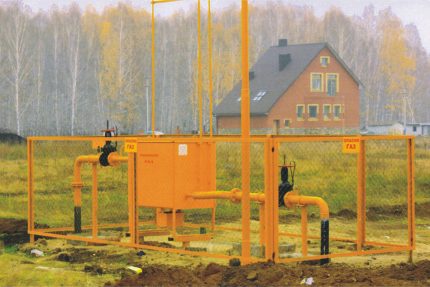
Difficulties may arise in the following cases:
- Great distance from home to the highway - The laying of a multi-kilometer pipeline can result in an impressive amount.
- The presence of the federal highway or a railroad track on the way - it’s very difficult and expensive to make out and “cross” a branch through a busy road, so most likely you will encounter a refusal.
- The path through private property - if the gas pipe cannot be allowed to bypass foreign sections, you will need to obtain written consent from their owners, who can, but are not required to provide it.
- Difficult terrain - if the area is replete with rocky soil, ravines and other natural barriers, the laying of an underground pipeline becomes an expensive and sometimes impossible project.
- Low bandwidth - if the pressure in the line itself is low, the question of new connections can be “frozen” for an indefinite period.
Therefore, if it is not about an already rebuilt building, but only the choice of a suitable site for a future home, consider options with already failed communications.
Ideally, the village should be equipped with a separate gas pipe, from which it is only necessary to make a branch to its territory. In this case, the negotiation process is reduced to a minimum.
The main stages of gasification at home
To start the gas "epic", you should find out in whose jurisdiction the main gas pipeline to which you plan to connect is located.
Usually it is a local GorGaz, but if you do not have information about its location and methods of communication, submit a request to local authorities. There, within 5 days you should be given an answer with information about the organization engaged in issuing technical conditions in your region.
Step # 1 - preparation of technical documentation
To complete the project with the subsequent installation of the gas pipeline, it is necessary to take into account the features of the local topography and other nuances. And this requires technical conditions.
To get them, prepare the following set of documentation:
- Copies of documents proving your ownership of the land plot where the cottage is located.
- Originals and copies of documents proving the identity of the applicant - passport, power of attorney.
- A situational plan of the settlement with an indication of the land where the gas supply is required, and the location of the highway itself. A graphic diagram with a fragment of the cadastral map is also suitable.
- Written consent from neighbors (if the pipeline route is laid through their territory).
- Calculation of the maximum hourly gas consumption, if it is planned to consume more than 5 m3 (usually for private houses from 300 m2).
If you do not know how to correctly calculate the heat consumption, you can shift this task to the contractor of the technical conditions or designer, providing information on the number and power of gas devices, as well as the size of the area where carried out heating. But most private houses and cottages fall into the category that does not require additional heat.
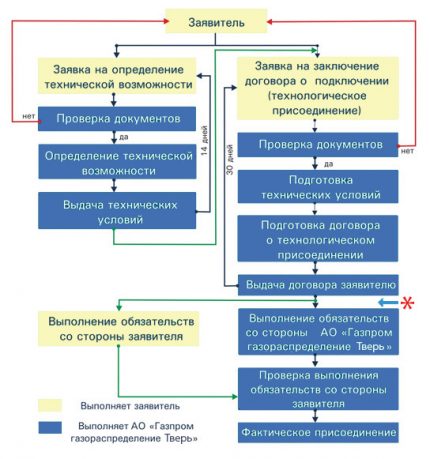
Then, a request is made for the provision of technical services indicating the personal data of the applicant (name, identification code and address of residence) and the planned date for putting the house into operation, if it is a construction in progress.
Documents are submitted to the organization responsible for the local gas main, where they must provide ready-made technical conditions or a reasoned refusal within 2 weeks.
The issued package of documents contains information about the gas pipeline to which the applicant will be connected, the maximum load on the branch, the timing of the connection, the term of the technical conditions, the recommended diameter and material of the pipes for the pipeline. In addition, the applicant will be required to install a gas meter.
We examined the issue of obtaining technical conditions in more detail in in our other article.
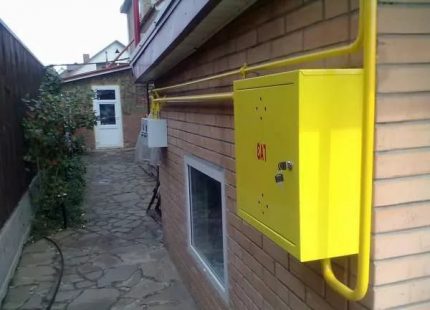
After studying the provided technical conditions, the owner of the house signs a connection agreement and agrees to pay for the work according to the schedule and tariffs indicated in the document.
Step # 2 - designing a connection project
When the first step has been completed and the technical conditions have been obtained, you should choose the organization that will draw up the project and prepare the home gas consumption network for connection to the highway. The fact is that the gas distribution company only undertakes to bring a branch to your site, and laying pipes on the territory adjacent to the house and wiring inside the house is already the owner's task.
Therefore, only contact licensed companies that have access to construction and installation works and specialize in developing projects for internal and external gas supply. It will not be superfluous to check recommendations from customers, because not only the cost and quality of work, but also the safety of operation of the future pipeline depends on your decision.

To prepare a project, you must provide the documents:
- A copy of the registration certificate for the house (or a construction project for construction in progress).
- Topographic plan of the site with all gasified facilities, utilities and a gas pipeline, approved by the gas service.
- Documents for gas appliances and equipment planned for installation.
- Received technical conditions.
After the conclusion of the contract, a design engineer should be sent to you, who will take all the necessary measurements to draw up a project for the layout of gas communications inside the house and on the site. With him, it will be necessary to coordinate the need for a boiler room device, the location of the meter and all gas appliances.
We spoke in more detail about the design of the gas supply system in this article.
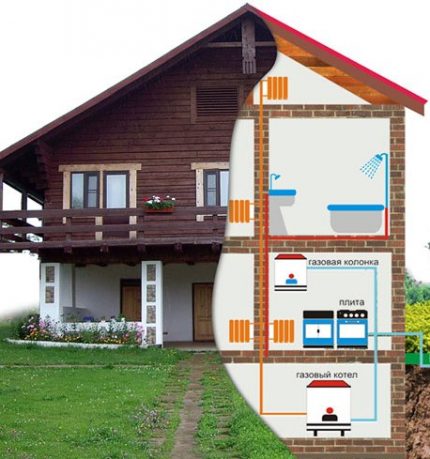
After drawing up the project, it is necessary to approve in all interested organizations, for example, the chief architecture, water canal, and the auto-track (a design company can also arrange obtaining visas).
Now it remains to submit a package of project documentation along with a signed contract for connection to the gas service and wait for the 14 days allotted by law, after which you will either be returned a revised plan for revision or allowed to act.
Step # 3 - construction and installation work on the site
When the documentary stage is completed, you can either proceed with the search for a construction company, or trust gas pipeline laying on the site of the organization that completed the project (if the latter has a corresponding license). Here they will make an estimate with a list of forthcoming works and their cost.
If the price suits you, an agreement is signed. In order to play it safe, it is worthwhile to clearly indicate the terms of work and provide in the payment section for a clause according to which a full settlement will be made only after the commission has approved the pipeline.
If the cost is sky-high, you can exclude from the budget works that do not require access and qualifications in order to do them yourself (though not every organization will agree to this) or search for a cheaper company.
After performing installation work on laying and wiring pipes, the contractor must provide executive documentation.To check and approve the gas pipeline section, a commission is assembled from representatives of the gas service, a construction contractor, inspectors for architectural and construction supervision, labor protection and the owner of the house.
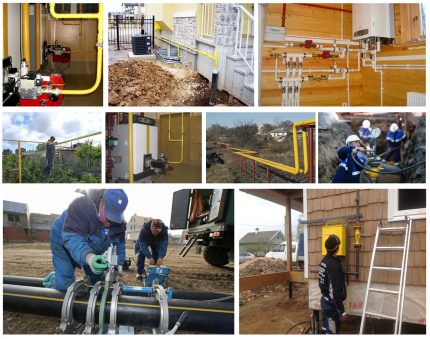
The commission makes a decision in a period of 2 to 4 weeks, after which it will be necessary to pay a receipt of technical supervision. Now you can conclude a contract for the supply of gas, maintenance of the gas pipeline and house equipment, seal the meter. Also, the owner of the house will have to undergo safety training in the gas service.
Step # 4 - piping and system startup
The final stage of gasification at home - check-in box pipeline in your territory to the main gas pipeline. This task is performed by gas workers after payment and agreeing on a date with you.
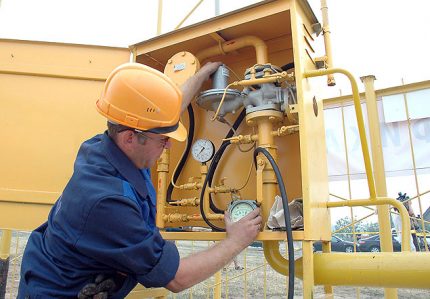
At the time of checking the equipment and the first gas supply, you need to call the employee of the organization with which the service contract was concluded.
After opening the branch valve, he must establish the optimal operating mode for the devices, make sure that they are working and instruct them in operation. After that, an act of acceptance of work is signed, a copy of which is filed with the project and archived.
Nuances of gasification in the adjacent area
Although most of the gas communications wiring is done by the contractor, the owner of the house will also be happy to figure out what's what. After all, if specialists are responsible for the safety of connections and installation of the system, then you will have to choose and buy gas appliances yourself. And about the landscape design of the site and the interior of the house, you should worry in advance.
Choosing a Pipeline Layout
To drive to the house, you can mount a system that passes through the air or underground. The first option is faster, and cheaper.
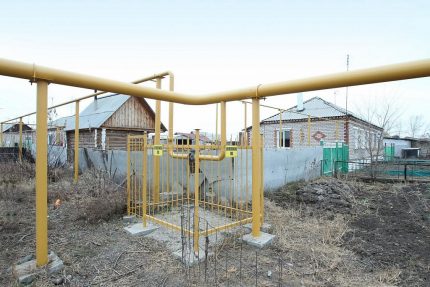
But the aboveground system has significant drawbacks: open pipes are more susceptible to corrosion and accidental damage. In addition, unscrupulous neighbors can easily make illegal insertions to them, and the appearance of the house is unlikely to benefit from interweaving with bright yellow pipes.
Therefore, if the terrain and the project budget allows, it is worth thinking about underground utilities. Such a system is much more reliable and safer, since it is protected from various accidents by a layer of soil; in addition, the wiring does not spoil the appearance of the site.
But the underground construction will cost 1.5-2 times more expensive, and it will require a lot of free space: there should not be any buildings at a distance of 2 m from each side of the gas pipeline. Another disadvantage is the difficulty in maintenance, because when a pipe breaks, you will have to re-raise the soil and look for a leak.
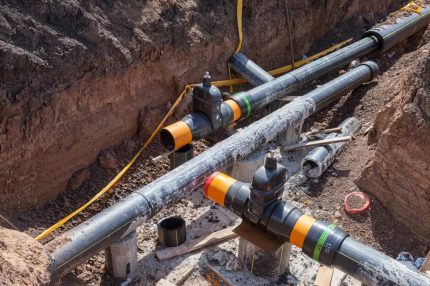
But the choice of the type of system depends on such nuances:
- If your branch passes through someone else's site, its owner may refuse to violate the fertile layer of the earth for the sake of an underground pipeline. However, there may be a reverse situation - when a neighbor does not like the idea of a ground pipe on supports, and he will require to mask the structure.
- If groundwater or rocky soil is located close to the site, it is better to stop at aboveground structures.
- If the pipeline needs to cross the highway or closely adjacent to a high-voltage power line, consider only underground structures.
There are combined gas pipelines, one part of which passes underground, and the second - through the air. But this option is quite complicated in the design and installation, so it is performed, most often, when you have to "transfer" a branch across the road.
The choice of material for pipes
For a gas pipeline, you need to buy only certified components, and this applies not only to pipes, but also to various connecting and locking elements - tees, crosspieces, elbows, plugs, couplings, adapters.
As for the pipes - most likely the material and the required diameter they will tell you in the gas service or design and installation company. But the most popular today are two options - traditional steel or relatively innovative plastic products.
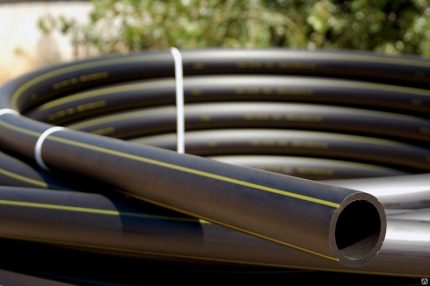
In addition, polyethylene pipes will not fail even in climates with harsh winters (up to -45 degrees), but weigh 7 times less than metal "competitors", which greatly facilitates installation and transportation.
Another significant advantage is the insensitivity of plastic to the effects of stray currents, therefore, electrochemical damage does not threaten your pipeline.
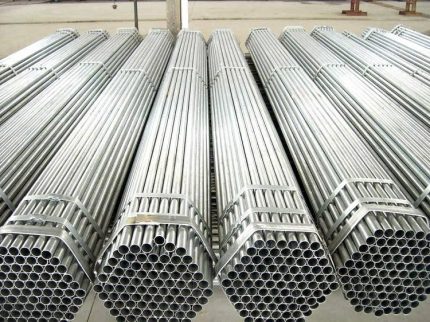
But low-carbon steel pipes are suitable for any gas pipelines - house, underground or surface. They are fastened by welding or using seamless joints.
For high pressure networks, it is recommended to use pipes with a diameter of at least 5 cm, for wiring around the house - from 2.5 cm. The wall thickness for an underground pipeline should not be less than 0.3 cm, for above-ground - 0.2 cm and more.
Heating boiler or boiler room?
The type and technical characteristics of a gas boiler directly depend on the area of the heated room. For 150 squares and 2 distribution points with hot water, wall-mounted equipment is quite enough, for a larger area, an outdoor boiler is already needed. Read more about choosing a gas boiler in next article.
In the room with the boiler, you need to install an exhaust hood, and ideally, a gas detector, which will warn of a carbon monoxide leak.
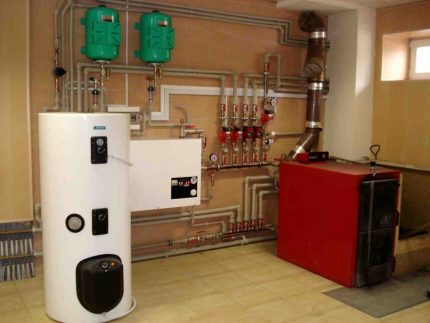
If the cottage area exceeds 200 m2, and the boiler power is 30 kW, it will be necessary to equip a separate boiler room, where you can place not only a gas boiler, but also a boiler, indirect heating boiler and other devices.
To do this, a separate room of 7.5 m3 or more is allocated, always with a window, a chimney, forced ventilation and a ceiling height of at least 250 cm.
Prices for gasification and ways to save
According to the new rules for connecting to gas pipelines prescribed in Decree No. 1314, the cost of connection depends on the category of consumers.
For private houses and cottages, there are three options:
- When the gas consumption is not more than 5 cubic meters per hour, the connection will cost 20 thousand rubles. At the same time, the distance in a straight line from the gas boiler to the gas distribution network should not exceed 200 m.
- For buildings where the estimated consumption is planned at the level of 5-15 m3 / hour, the supply to the border of the site will cost around 50 thousand.
- If the volume of consumption exceeds 15 m3 / hour, an individual calculation is performed.
This cost includes the development by the gas distribution organization of technical conditions and the supply of pipes from the main gas pipeline to the owner’s territory.
For a fee, you can agree on installation work on the site. Usually, the cost of such services is cheaper than that of private organizations, but the lead time is much longer, and with high workload they can even stretch for an indefinite period.
Designing a project is a separate item of expenses that will cost from 10 to 100 thousand rubles (a lot depends on the region and the size of the building). If you give preference to a company that is not only engaged in design, but also has a license for installation work, you can save up to 20-35%.

Collective joining is another option for those who are looking for a way to connect their cottage to gas with the least loss of funds. In addition, many localities have regional connectivity programs and subsidies.
In more detail, the cost of gasification of a private house, we discussed here.
Conclusions and useful video on the topic
To make it easier to understand the nuances of gas supply to your cottage, we recommend that you familiarize yourself with a small selection of video materials.
About the paperwork for joining the gas pipeline and the cost of certain types of work:
The order of the gasification of the house - the nuances of connecting to the main pipeline:
Stages of gasification of a private house:
And finally, advice. If the highway is far away or the specifics of the terrain pose difficult tasks for bringing the pipeline to the site, there is an alternative option for delivering “blue fuel” to the house - autonomous gasification with a gas tank.
Have you completed the gasification of your house the other day and want to share your experience with other owners of country houses? Leave your comments in the block under the article - tell us how much this event cost you, did you do something on your own or did you entrust the entire amount of work to the specialists? What pipes have you recommended for laying a gas pipeline? Many users will appreciate your advice.

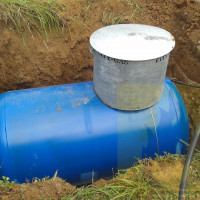 Autonomous gasification of a private house: arrangement of a gas supply system for cylinders and a gas tank
Autonomous gasification of a private house: arrangement of a gas supply system for cylinders and a gas tank  How to cut a pipe with gas: the procedure, rules and stages of work
How to cut a pipe with gas: the procedure, rules and stages of work  How to conduct gas in a bathhouse from home: the subtleties of gasification of a bathhouse
How to conduct gas in a bathhouse from home: the subtleties of gasification of a bathhouse 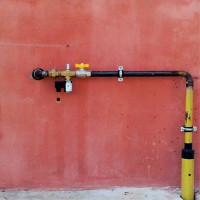 Laying a gas pipeline in a case through a wall: the specifics of a device for introducing a pipe into the house
Laying a gas pipeline in a case through a wall: the specifics of a device for introducing a pipe into the house 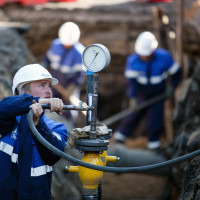 Gas line pressure testing: how are control tightness tests carried out
Gas line pressure testing: how are control tightness tests carried out 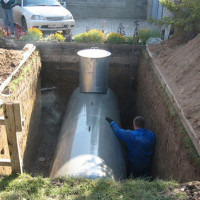 Installation and installation of a gas tank for a private house: the procedure for design and installation work
Installation and installation of a gas tank for a private house: the procedure for design and installation work  How much does it cost to connect gas to a private house: the price of organizing gas supply
How much does it cost to connect gas to a private house: the price of organizing gas supply  The best washing machines with dryer: model rating and customer tips
The best washing machines with dryer: model rating and customer tips  What is the color temperature of light and the nuances of choosing the temperature of the lamps to suit your needs
What is the color temperature of light and the nuances of choosing the temperature of the lamps to suit your needs  Replacement of a geyser in an apartment: replacement paperwork + basic norms and requirements
Replacement of a geyser in an apartment: replacement paperwork + basic norms and requirements
Like it or not, it’s the cheapest way to heat gas at home. Of course, everything is written sensibly, in the case, but they’re doing it completely wrong with us. First, run for half a year, or even a year, sign a piece of paper, bow to each instance, bureaucracy, and then give the money back and only then something will stir. Sore.
Is it possible to conduct gas if the house is not registered in the BTI? To be more precise, the passport is on the old house, which is significantly rebuilt.
Good afternoon. Gas connection is impossible without registering a house in the BTI, a registration certificate and an act recognizing a house as residential with registration in Rosreestr. It is likely that the gas workers will lead the pipe to you without it (a ground certificate will be enough), but connecting and starting the gas in this case is definitely impossible. Of course, registration of an old house will not work here, in fact the buildings are different.
A complete list of the necessary documents will be issued to you upon receipt of the technical conditions. I also recommend that you immediately check with the new gasification rules for a private house, which will take effect very soon - from 06/06/2019.
Hello Denis. If I were you, I would rather worry about the speedy legalization of the reconstruction of the house and the privatization of its new parts, because now your reconstruction is considered illegal and you can be held responsible for this. True, in practice, there are usually no problems with legalization if you built everything without violations and do not bother anyone. As Aleksey noted, that’s all right, the gas will be brought to your house as it is brought to the plots, but commissioning and the house is unlikely, there will be no gasification project.